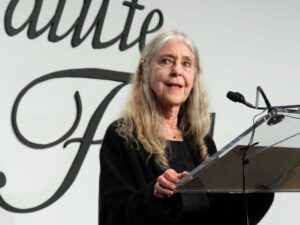Intrepid Museum honors Apollo software engineer Margaret Hamilton

NEW YORK — The Intrepid Museum in New York City kicked off a summer of Apollo events May 23 by honoring software engineer Margaret Hamilton with the institution’s Lifetime Achievement Award.
Hamilton led the team of programmers who ran the computers on both the command module and the landing module of the Apollo 11 mission. When she began her career, the field was so young that the term software engineering did not yet exist; Hamilton coined it herself.
“The software experience itself was at least as exciting as the events surrounding the mission,” Hamilton said during her acceptance speech at the awards ceremony. “As developers, we had the opportunity of a lifetime, to make every kind of error humanly possible.”
All those errors were made before Apollo 11 launched, to be clear. As Hamilton and her colleagues were working on the project, they were always conscious of how well-tuned the software needed to be.
“Astronauts’ lives were at stake. It had to work. The first time,” Hamilton said. “Not only did it have to be ultrareliable, it would need to be able to detect an error and recover from it in real time. Problems had to be solved [that programmers had] never solved before.”
But Hamilton also recounted a key turning point of the mission, just as Neil Armstrong and Buzz Aldrin were preparing to touch down. “Everything was going perfectly; Walter Cronkite was reporting the mission in great detail,” she said. “All of a sudden, something totally unexpected happened. Just as the astronauts were about to land on the moon, the software’s priority displays interrupted the astronauts’ normal mission displays and replaced them with priority alarm displays to warn them there was an emergency.”
The alert was triggered by a switch that was misaligned; the astronauts fixed it and landed safely. “The Apollo 11 astronauts became the first humans to walk on the moon,” Hamilton said. “Our software became the first software to run on the moon.”
That moment was pivotal for more than just the field of computer science, former NASA astronaut Mike Massimino, who presented Hamilton with the award, noted during his introduction. “It is because of developments like this and pioneers like Margaret that the United States was able to continue its work that led ultimately to a reusable spacecraft, the space shuttles, which I had the privilege to fly on twice,” he said. “I and all of my astronaut colleagues owe you a personal debt of gratitude.”
During her remarks, Hamilton also shared memories from her career before joining the Apollo effort, including how she began her computer science work by developing programs to better predict the weather. She also touched on her software engineering work on MIT’s Semi-Automatic Ground Environment (SAGE) project, which helped military personnel detect enemy planes.
That program ran on a notably cantankerous computer, she said. “The machine was huge; if your program crashed, the computer would tell on you with sirenlike and foghornlike sounds throughout the building that everybody could hear and flashing lights that everyone could see,” Hamilton said. “Everyone would come running to find out who the guilty one was. We used a Polaroid camera to take a picture of the bug together with the person who caused it.”
Hamilton is still an active software engineer, pursuing a new system that prevents errors before they occur, rather than addressing them after they arise. That work builds directly on her experience with the Apollo program, she mentioned during her remarks.
“Whatever success I may have experienced, much of it was because I was in the right place at the right time with the right opportunities and the right people,” Hamilton said. “I had the benefit of beginning with no preconceived notions. Much of the credit goes not only to those I have learned from, but also to the errors I have had the opportunity of having had some responsibility in their making, without which we would not have been able to learn the things we did.”
Those glitches and mistaken pathways were crucial, she continued. “The errors showed us what to do and where to go, each holding answers to questions we had not thought of asking,” Hamilton said. “They told us how to exist without them.”
This story originally appeared on Space.com.
from SpaceNews.com http://bit.ly/2QvSJb0
Comments
Post a Comment